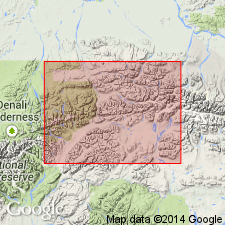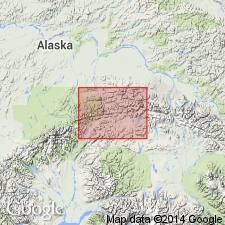
- Usage in publication:
-
- Usibelli Group*
- Modifications:
-
- Named
- Biostratigraphic dating
- Dominant lithology:
-
- Coal
- Lignite
- Sandstone
- AAPG geologic province:
-
- Alaska East-Central region
- Alaska Southern region
Summary:
Named for settlement of Usibelli and defined to consist of (ascending): Healy Creek, Sanctuary, Suntrana, Lignite Creek, and Grubstake Formations. Type section consists of composite of type sections of Healy Creek, Sanctuary, Suntrana, Lignite Creek Formations and reference section of Grubstake Formation, located on north bank of Healy Creek and along lower part of Suntrana Creek, Healy D-4 quad, AK. Total thickness is 1940 ft. Overall age ranges from late Oligocene to late Miocene based on plant fossils from component formations.
Source: GNU records (USGS DDS-6; Menlo GNULEX).

- Usage in publication:
-
- Usibelli Group*
- Modifications:
-
- Age modified
- AAPG geologic province:
-
- Alaska East-Central region
- Alaska Southern region
Summary:
Overall age is late Eocene and early to late Miocene based on reinterpretation of ages of fossil plants in Usibelli Group's basal unit, Healy Creek Formation, and recognition of major hiatus within unit spanning entire Oligocene (and part of late Eocene) time.
Source: GNU records (USGS DDS-6; Menlo GNULEX).
For more information, please contact Nancy Stamm, Geologic Names Committee Secretary.
Asterisk (*) indicates published by U.S. Geological Survey authors.
"No current usage" (†) implies that a name has been abandoned or has fallen into disuse. Former usage and, if known, replacement name given in parentheses ( ).
Slash (/) indicates name conflicts with nomenclatural guidelines (CSN, 1933; ACSN, 1961, 1970; NACSN, 1983, 2005, 2021). May be explained within brackets ([ ]).

